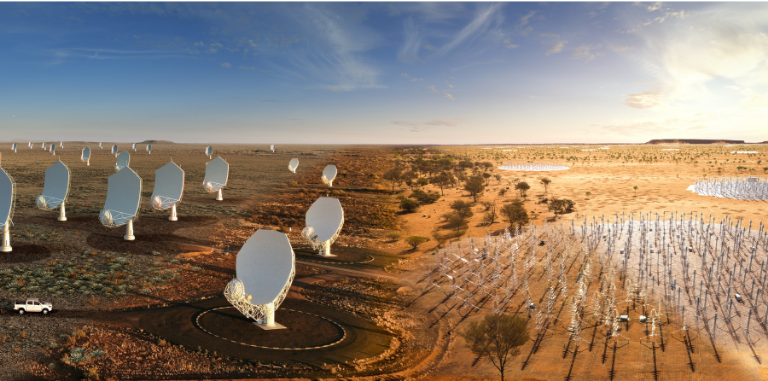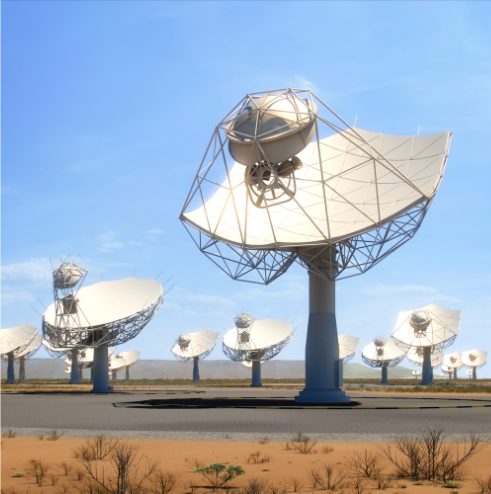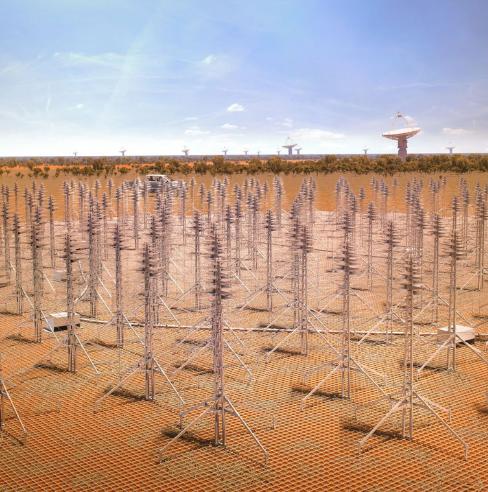University of Manchester Staff Help Design New Transformational Radio Telescopes
Welcome to Physics 6 July 2021
In a historic moment for radio astronomy, the Square Kilometre Array Observatory (SKAO) was officially launched in February this year, marking an important milestone for staff at the University’s Jodrell Bank Centre for Astrophysics, and building on the University’s long heritage in radio astronomy.

Designing the SKAO telescopes – a Big Data challenge
With its global headquarters located at the University’s Jodrell Bank site, the SKAO is an international collaboration which will build and operate two cutting-edge radio telescopes. The SKAO telescopes, however, are not single dish radio telescopes, but instead consist of telescope arrays. The low-frequency telescope (SKA-Low), containing an array of 131,072 antennas, will be located in a sparsely populated region of Western Australia, while the mid-frequency telescope (SKA-Mid), containing an array of 197 radio telescope dishes will be located in a radio-quiet area of South Africa. Together these next-generation telescopes will revolutionise our understanding of the Universe.
With such an immense array of elements, the SKAO telescopes pose not solely an engineering challenge, but a Big Data challenge as well. Professor Keith Grainge and his team were chosen to lead an international consortium to design the signal and data transport system, which will be the backbone of the SKAO telescopes. A series of networks will connect each of the individual antennas and dishes to the rest of the SKA infrastructure. Using enough optical fibre to wrap around the Earth twice, these networks will transport not only science data, but the data required to control, monitor and calibrate the telescopes.
Across the two telescopes, a total of around 30 terabits per second of data will be transported from the array sites to processing facilities in Perth and Cape Town for the SKA-Low and SKA-Mid telescopes respectively. That’s around 200,000 times faster than the projected global average home broadband speed for 2022! Here high-performance supercomputers, with processing speeds of around 135 Petaflops, will produce the science data that will be sent to the SKA Regional Centres for astronomers around the world to analyse. A phenomenal 600 Petabytes of data will be sent each year, that’s enough data to fill more than a million average laptops!
Professor Keith Grainge tells us more.
“We have now completed the design for the SKA data transport system and had it successfully reviewed by an international panel of experts. However, data transport technology is improving very rapidly, giving us the possibility of using much more efficient transceivers, so we are always evolving our design to make use of cutting edge equipment as we go into the construction phase of the SKA Project.”
As well as working on the transfer of science and monitoring data, the team have developed the synchronisation and timing system which provides the incredibly high timing and frequency precision needed for both SKA operations and science. The accuracy required is equivalent to a million-millionth of a second (a picosecond), so short a time that even light can travel less than a millimetre during the period.

Credit: SKAO.
Testing theories of fundamental physics.
The huge increase in sensitivity and resolution provided by the SKAO telescopes will not only revolutionise our understanding of cosmology, galaxy evolution, and planet formation, it will also enable us to test theories of fundamental physics. Back in 1915, Einstein’s theory of general relativity predicted the existence of gravitational waves, distortions in space-time resulting from the rapid motions of very massive compact objects. But the first direct observation was only made in 2015 by the LIGO Scientific Consortium, making headlines across the globe.
The SKAO telescopes will provide an opportunity to use pulsars to form a Galaxy-scale gravitational wave detector!
Rapidly spinning neutron stars known as pulsars, emit radio beams from their poles and the lighthouse-like pulses which arrive at Earth can be measured incredibly accurately allowing them to be used as high precision cosmic clocks. Minute changes in the arrival times of these pulses will allow us to detect the occurrence of gravitational waves.
But to build a gravitational wave detector, a huge number of new pulsars throughout the Galaxy will need to be identified, creating a cosmic pulsar census, and that’s where astronomers at JBCA come in. They have designed the hardware and software needed to perform searches of the vast volume of data that will be obtained by the SKAO telescopes. Professor Ben Stappers, who has been leading the design along with a team at the University of Oxford, explains;
“To find large numbers of the most rapidly spinning pulsars with the SKAO telescopes is computationally very challenging, we have to search thousands of positions on the sky simultaneously. The data rates are so enormous that we must do this processing in real time, something never before attempted. This will require extremely robust and efficient code and we have been involved in this since inception of the project and are looking forward to delivering during construction phase.”
Building on current expertise
The creation of the SKAO heralds a new generation of radio telescopes, but their design has been built on decades of experience with the current global ground-breaking radio telescope facilities. These include the University’s Lovell Telescope and the e-MERLIN National Facility (which is operated by the University for the Science and Technology Facilities Council). These telescopes have not only played an important role in the design of the SKAO telescopes, but will also be crucial in performing both complementary and follow-up observations for years to come.
Professor Mike Garrett is Director of the Jodrell Bank Centre for Astrophysics;
“SKA pathfinders like e-MERLIN are playing a key role in preparing the astronomical community for the era of SKA science operations – many of the fundamental techniques of interferometry were developed here, and it’s great to see us continue to play such an important role in the new designs that Ben and Keith are pioneering. “

The SKAO and the future?
So what’s next for the SKAO telescopes? With the construction phase having now officially started, and prototype dishes and antennas already stationed on the SKA sites, the University teams’ involvement with the project hasn’t ended with the design phase. They continue to work with the SKAO and international partners to deliver crucial elements of the synchronisation and timing systems, the pulsar search engine and development of the software for the monitoring and control of the telescopes. Meanwhile throughout construction JBCA astronomers will continue their research towards answering some of the most important questions in science today and preparing for the transformational experiments that will be allowed by the SKAO telescopes.
big datacosmologyengineeringfundamental physicsgalaxy evolutioninterferometryOptical fibreplanet formationpulsarsradio astronomyradio telescopessoftwareSouth Africasquare kilometre arraysynchronisation and timing systemstelescope arraysWestern Australia




Leave a Reply